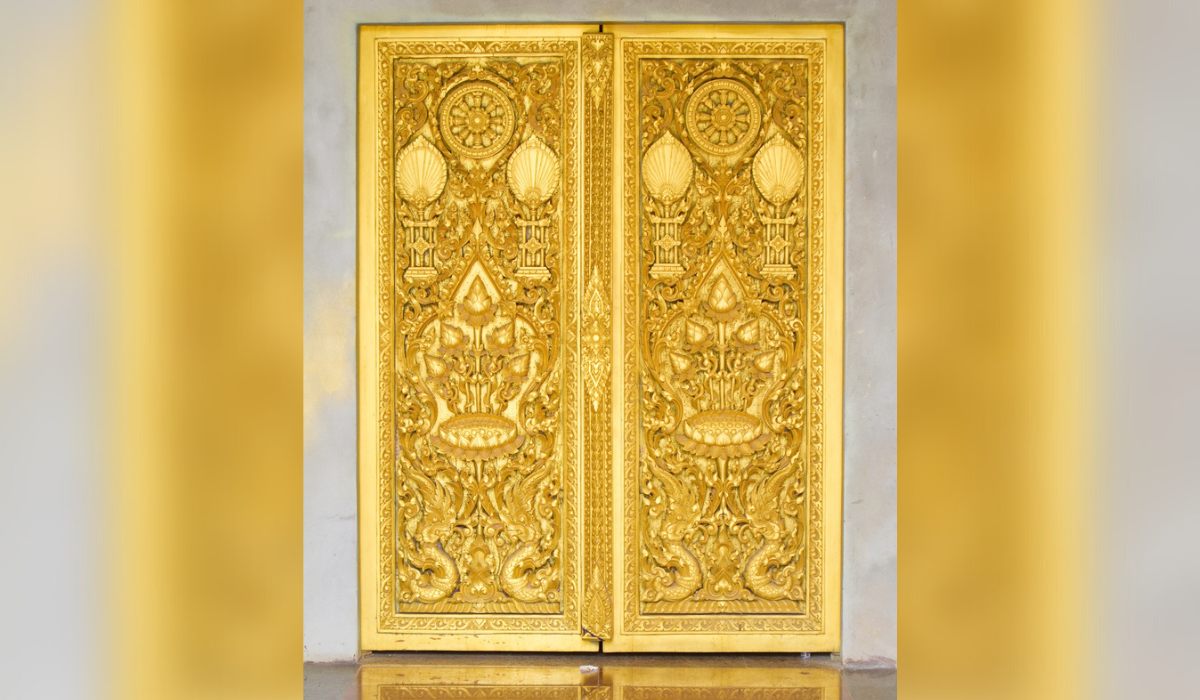An integral part of all Indian households, a beautiful pooja room adds a touch of spirituality to your home. This serene space serves as a place for prayer and meditation. The central element in any pooja room design is its entrance door. A well-chosen pooja room door design can instantly transform the ambiance of your sacred area while maintaining its sanctity. Crafted from diverse materials, there’s a plethora of exquisite pooja room door designs available to select from.
See also: Small temple design ideas for your home
Importance of pooja room door design
There are two essential reasons behind a pooja room door’s significance. According to the principles of pooja room Vastu, doors and thresholds are essential elements for maintaining cleanliness within the sacred space by preventing insects and impurities from entering. Similarly, in Hindu mythology, deities are believed to take human forms and therefore require privacy. Temples often close the doors to the inner sanctum after serving food to the deity, symbolising their privacy. Pooja room doors hold cultural importance as they reflect these aspects. Secondly, an appealing pooja room door design can also have a transformative impact on the overall ambience of the space.
Modern pooja room door designs for home
Browse through these trending pooja room door design ideas for inspiration.
Glass pooja room door designs
Integrating glass into mandir door designs introduces an element of sophistication and enables the soft illumination of natural light. Stained or frosted glass can be employed to offer privacy while preserving a feeling of translucence. Elaborate divine symbols, religious motifs or floral patterns can adorn the glass, contributing to a tranquil and celestial atmosphere within the pooja room.
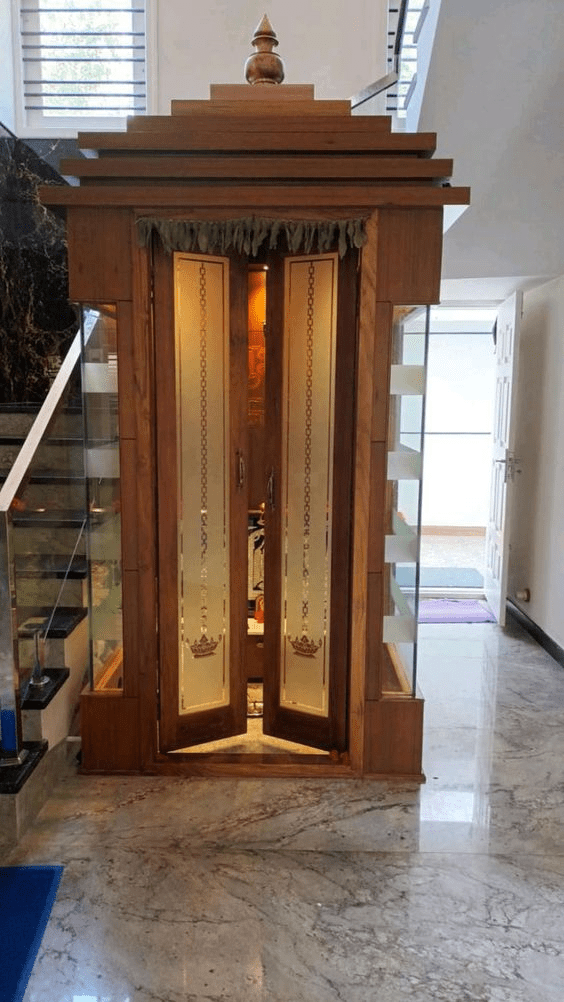
Source: Pinterest
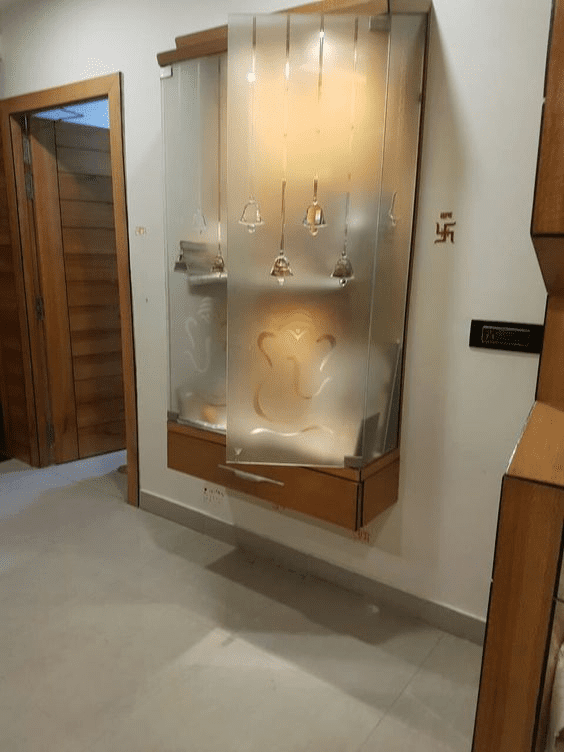
Source: Pinterest
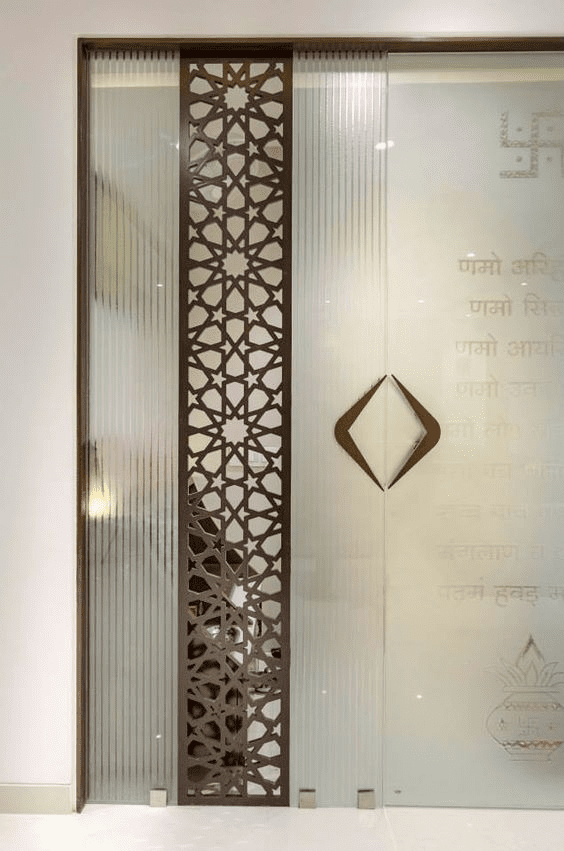
Source: Sindhu (Pinterest)
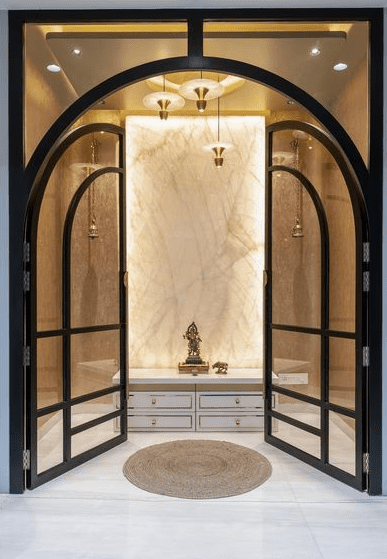
Source: Pinterest
Wood and glass pooja room door designs
Merging wood and glass in pooja room door designs achieves a fusion of traditional and modern aesthetics. Wood imparts a feeling of warmth and opulence, while glass introduces a contemporary flair and enhances visibility. Elaborate religious motifs can be intricately carved onto the wooden door, while glass panels can showcase stained glass artwork or etched designs. This combination results in a seamless interplay of materials, crafting a visually captivating and spiritually enriching pooja room entrance.
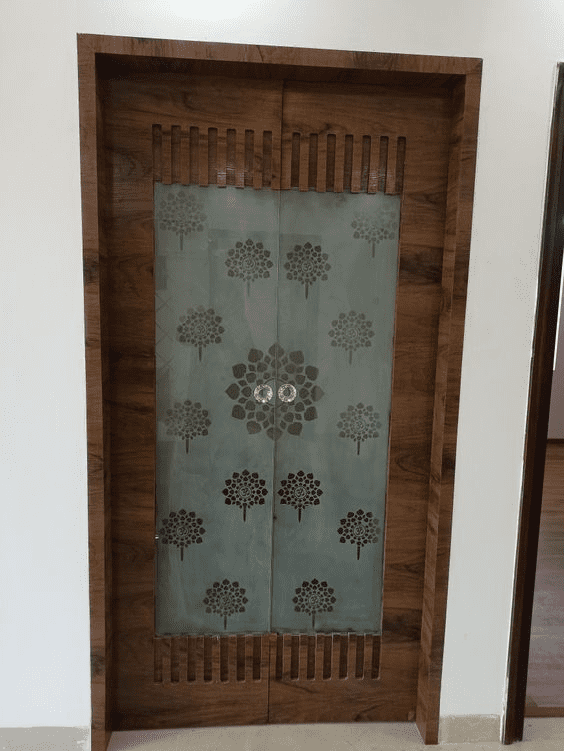
Source: Pinterest (SP Interiors)
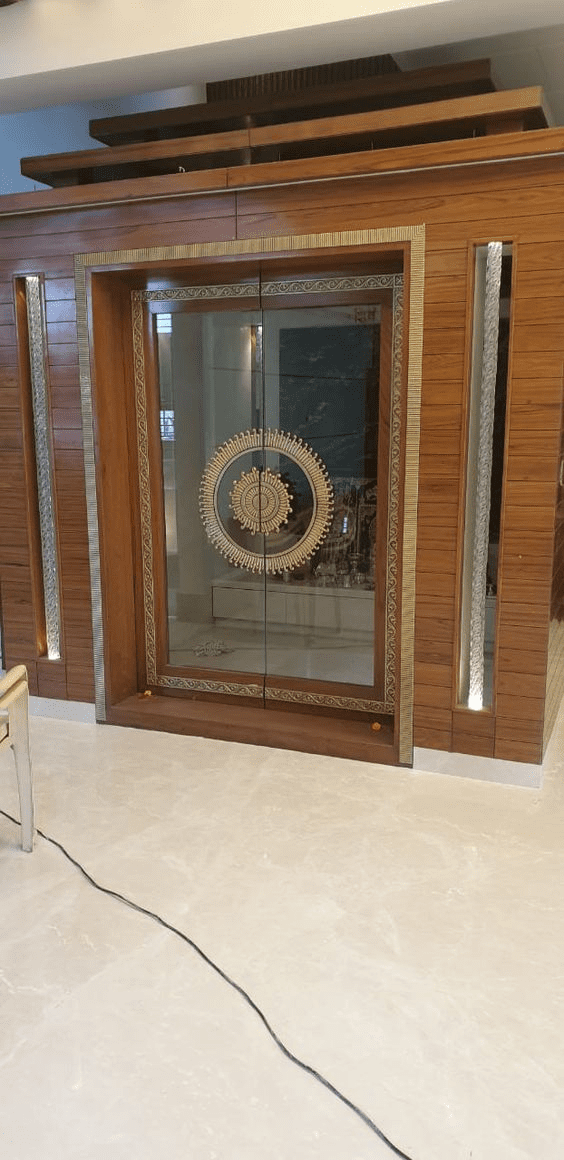
Source: Pinterest

Source: Pinterest
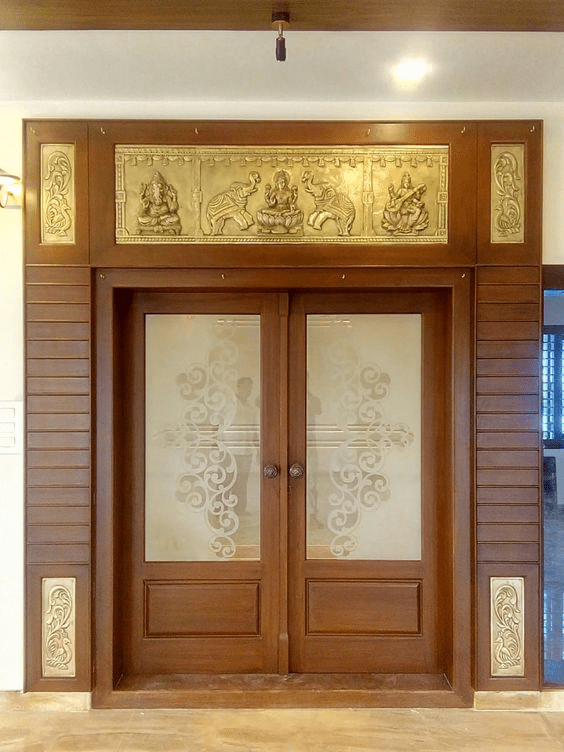
Source: Pinterest
Wooden pooja room door designs
A wooden door for the pooja room emanates sophistication through its luxurious grain patterns and inviting warm hues. Meticulously crafted, it can boast intricate carvings that portray religious motifs, instilling a sacred atmosphere. The door is built with a robust frame and a sleek finish, augmenting both its longevity and aesthetic charm. The designs can encompass elaborate floral motifs, geometric figures, or divine symbols, blending elements of tradition and modernity. Alternatively, a minimalist approach with clean contours and delicate accents can cultivate a tranquil ambiance. Choosing between a natural wood finish or a polished appearance further enhances the door’s enduring elegance.

Source: Pinterest (Vishnu Das)
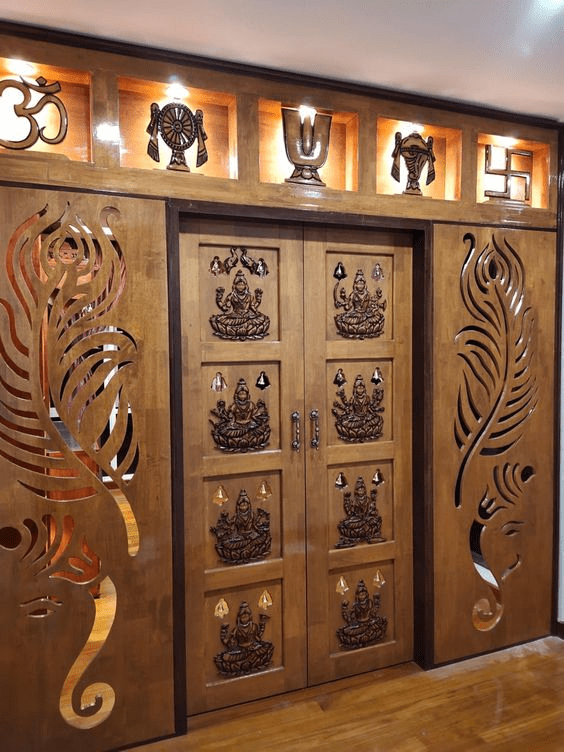
Source: Pinterest (Nisha Nair)
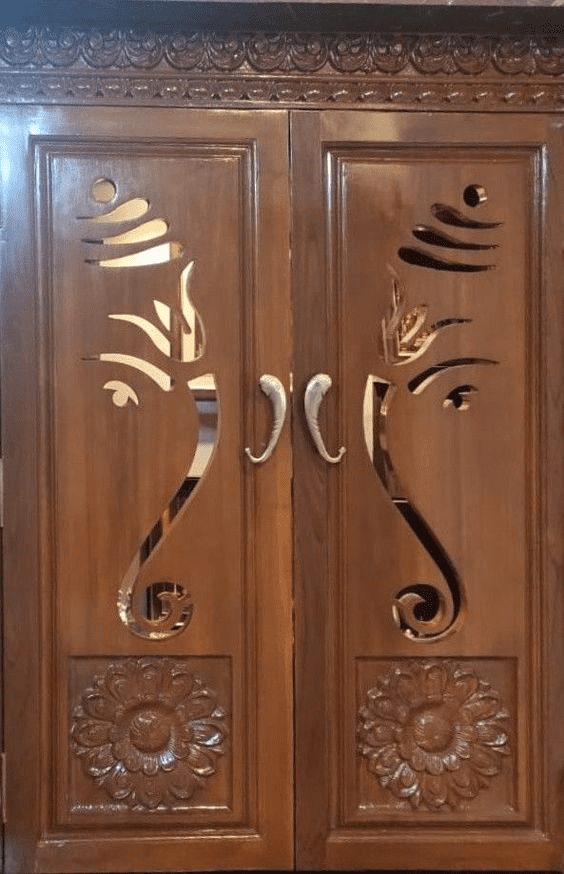
Source: Pinterest (Faizan Home Decor)
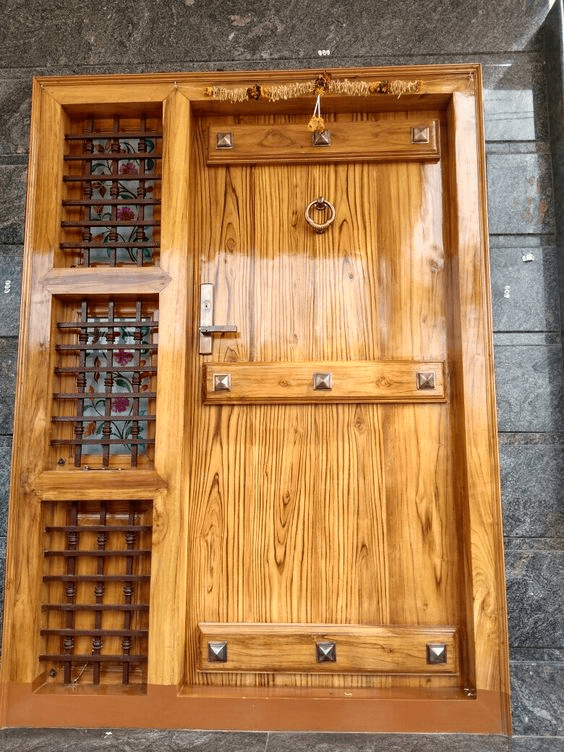
Source: Pinterest
Plywood pooja room door designs
The pooja room doors crafted with plywood radiate a modern allure with its sleek and minimalistic design. The plywood’s smooth surface and inherent grain pattern infuse a sense of cosiness. These door designs guarantee durability and protection against warping. The designs may showcase laser-cut motifs, geometric arrangements, or elegantly engraved symbols, introducing a contemporary spin on traditional aesthetics. The door’s visual charm can be elevated through a combination of contrasting wood finishes or a lustrous varnish. Offering a stylish and adaptable choice, plywood doors serve as an inviting entryway to the pooja room.
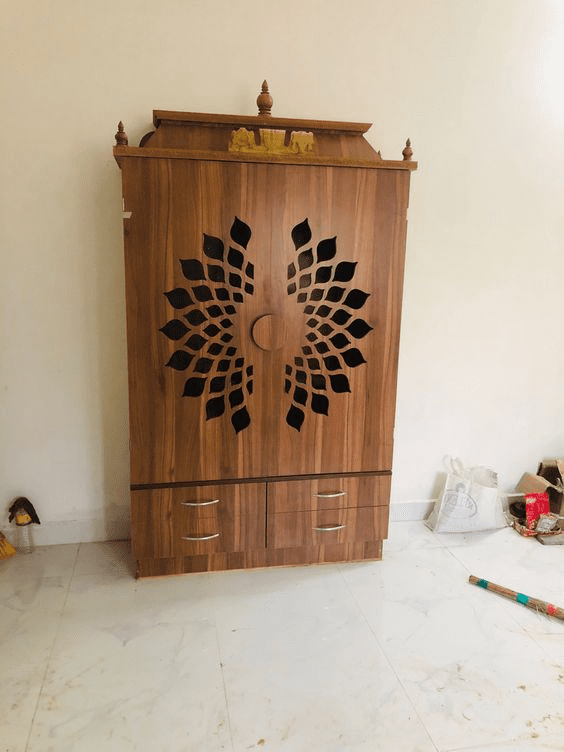
Source: Pinterest (Gowri Ganesh)

Source: Pinterest (U2sandeep)
Pooja room door designs with lighting
There are plenty of ways in which you can accentuate your pooja room door design with lighting. For example:
- Embed LED lights behind stained, or frosted glass panels to establish a celestial radiance.
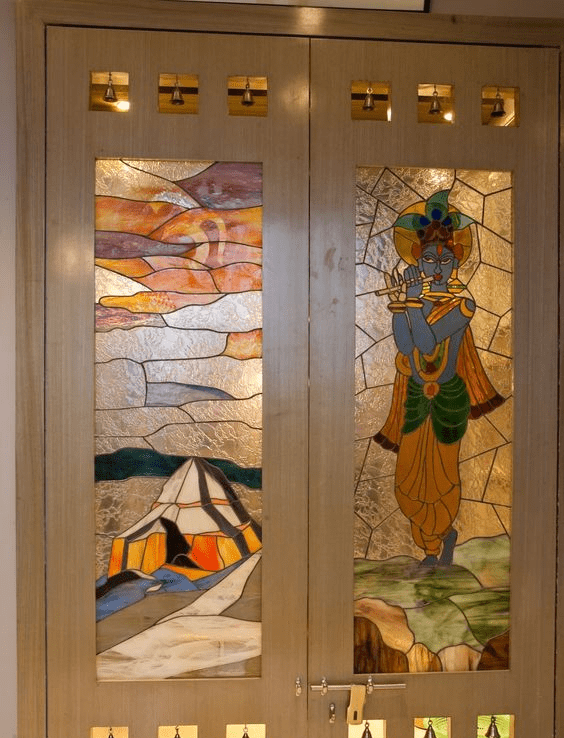
Source: Homify India (Pinterest)
- Incorporate LED strips into the pooja room door design by outlining the door frame or creating a border using these strips.
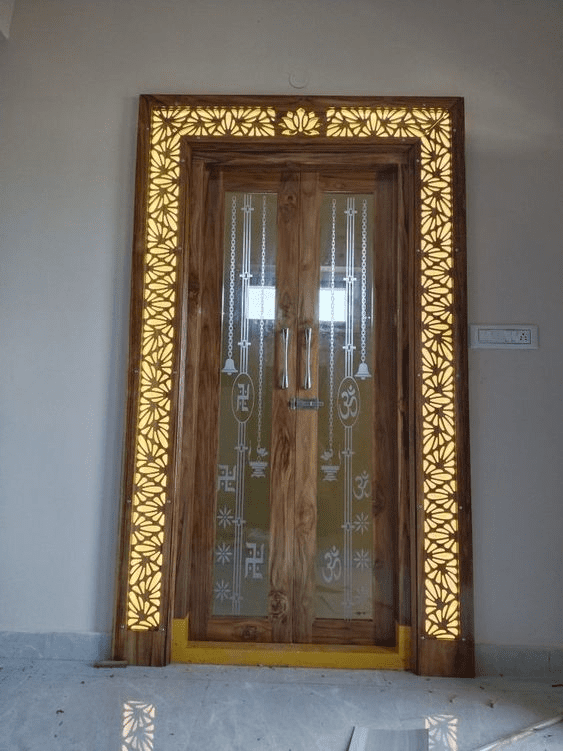
Source: Pinterest (Home Decorations)
- Set up recessed ceiling lights right above the pooja room door, casting a gentle and indirect illumination.
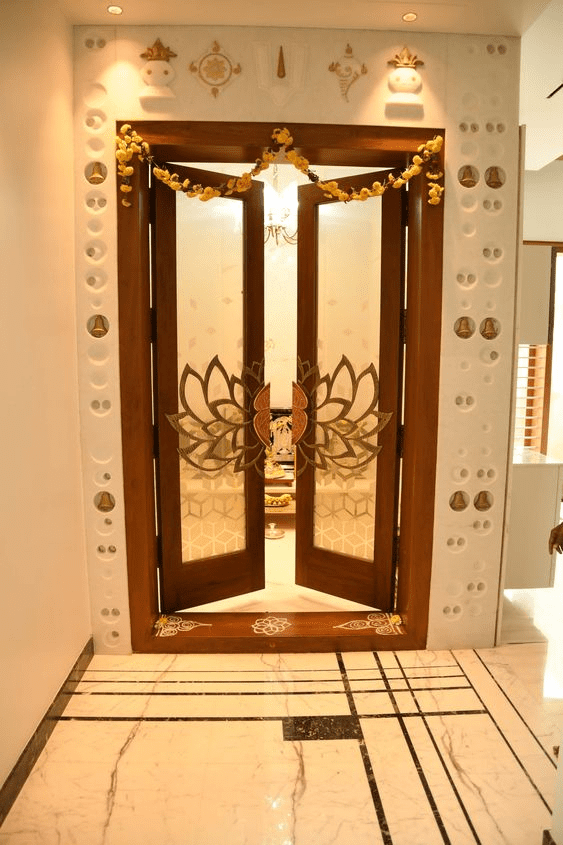
Source: Pinterest (Artisticks)
- Adorn the surroundings by suspending pendant lights on each side of the pooja room door, creating a decorative and captivating visual.
Pooja room door designs with jaali
When selecting a mandir door design for your home, consider the significance of jaalis. They provide a traditional touch with timeless appeal and come in various materials such as wood, acrylic, CNC, or laser-cut MDF, catering to different budgets. A key advantage of jaalis is their ability to offer partial visibility into the pooja room while allowing for ventilation.
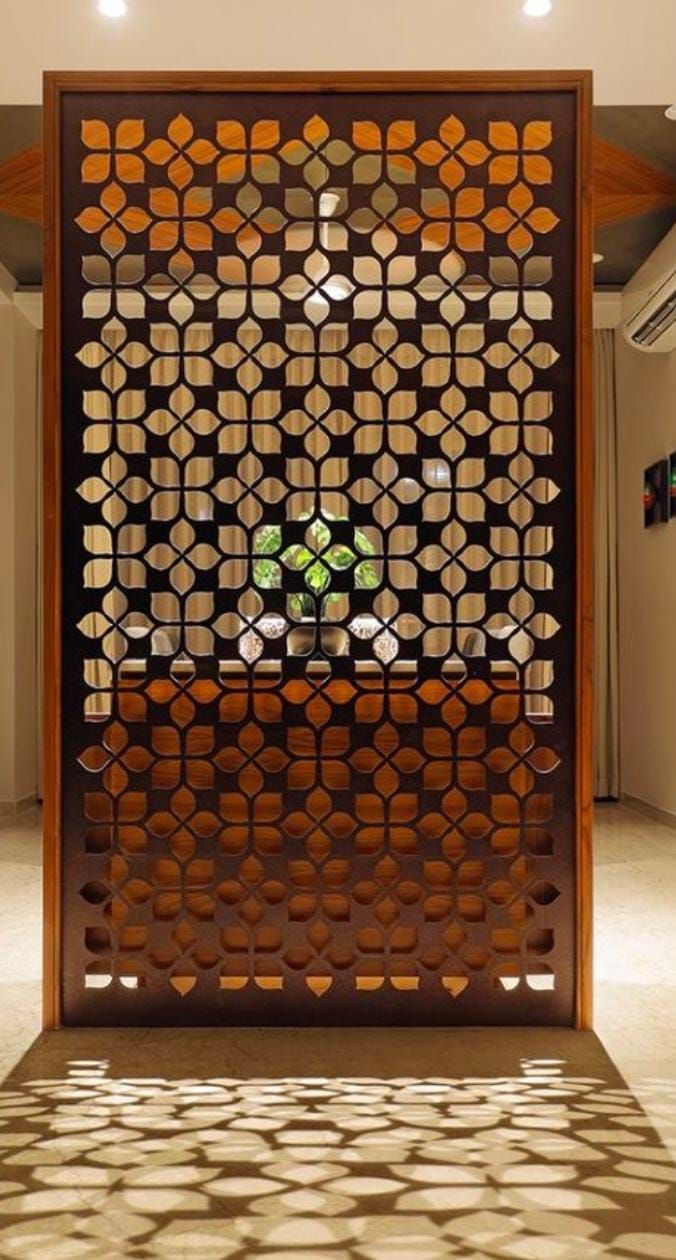
Source: Pinterest
Foldable pooja room door design
If space is limited and a pair of intricately carved pooja room doors isn’t feasible, consider opting for bi-fold doors instead. These doors fold together when closed, rather than swinging outward. This space-saving design also serves as a practical room divider.
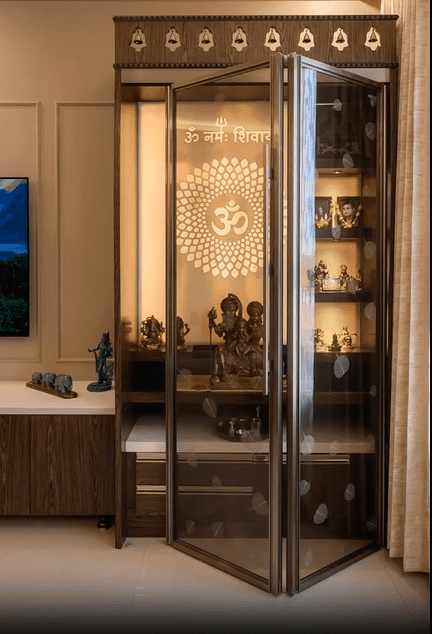
Source: Pinterest
Sliding pooja room door design
Perfect for compact homes or modern apartments, sliding doors offer a space-efficient solution without compromising on design. Whether fully frosted glass with divine motifs or sleek wood panels with metallic handles, sliding pooja doors are both functional and stylish. They allow flexibility in layout and can be left partially open during rituals without obstructing movement.

Source: Pinterest
Acrylic laser-cut pooja room door design
Acrylic laser-cut panels are lightweight, cost-effective, and offer high design flexibility. These doors can feature intricate cut-outs of deities, Sanskrit shlokas, or floral motifs, and can be backlit for a divine glow. The modern material allows for vibrant colours or metallic finishes, suiting eclectic and contemporary homes alike.

Source: Pinterest
Arched pooja room door design
An arched pooja room door design brings a touch of traditional temple architecture into modern homes. The graceful curve of the arch creates a regal entrance, often enhanced with wooden carvings or brass embellishments. This design evokes serenity and grandeur, making it a timeless choice for sacred spaces.

Source: Pinterest
Colour options for pooja room door design
Choosing the right colours for your pooja room door design is essential for creating the desired atmosphere and aura. Here are the top five colour options and their significance for pooja rooms.
White pooja room door design
White represents purity, spirituality, and peace. It establishes a calming and serene environment, crucial for maintaining focus during meditation and prayers. Opting for white doors in the pooja room can enhance the feeling of tranquillity and divinity.
Gold pooja room door design
Gold signifies prosperity, opulence, and spiritual enlightenment. According to Vastu, gold is highly auspicious and suitable for a pooja room. You can select a pooja room door with a golden finish or gold accents to add a sense of elegance and grandeur to the space.
Red pooja room door design
Red is an energising and vibrant colour associated with passion, power, and devotion. It symbolises auspiciousness and strength in the Indian culture. Pooja rooms with red doors evoke fervour, devotion, and a deep commitment to the divine.
Blue pooja room door design
Blue is a soothing and calming colour that symbolises spirituality, serenity, and peace. It is associated with divinity and believed to promote contemplation and meditation. Pooja rooms with blue doors establish a peaceful atmosphere that fosters a stronger connection with the spiritual realm.
Green pooja room door design
Green represents fertility, abundance, and prosperity, creating a harmonious atmosphere. Green doors in a pooja room generate a feeling of renewal and balance, fostering a connection with nature and the almighty.
Materials for pooja room door designs
When selecting materials for your pooja room door, consider the following options:
Wood
Wood is a favoured choice for pooja room doors owing to its timeless charm and natural warmth. It offers a divine feel and emits a spiritual aura. Woods like rosewood, teak and sheesham are considered highly auspicious for pooja rooms. They can be used to create solid panels or intricately carved doors.
Glass
Glass can be either used alone or in combination with other materials for pooja room doors. Stained or frosted glass provides privacy while permitting soft light to filter through. Glass panels can be adorned with divine symbols, religious motifs, or floral designs, adding a sacred and ethereal touch to the door.
Metal
Metal doors, particularly bronze or brass, are commonly found in pooja rooms. They showcase engraved religious symbols or intricate carvings, displaying exquisite craftsmanship. Opting for a metal door imparts a sense of symbolism and grandeur to the pooja room.
Plywood
Plywood offers versatility and cost-effectiveness for pooja room doors. It allows for options like carved patterns, laser-cut designs, or intricate detailing, ensuring a diverse outcome. Unlike other materials, plywood doors are durable and can be highly customised.
PVC
Polyvinyl chloride (PVC) doors are budget-friendly, resistant to moisture and lightweight. This makes them suitable for pooja rooms in humid environments. With low maintenance and easy customisation in a variety of colours, PVC doors are ideal for any interior style. Whether religious motifs, embossed patterns or traditional designs, various options are available for selection.
Vastu for pooja room door design
Here are some Vastu tips for choosing the best pooja room door designs:
- Place the pooja room door in the northeast or east direction to harness positive energy and divine blessings. Avoid the southwest direction as it is deemed inauspicious.
- Use solid materials like metal or wood for the door to symbolise stability, strength, and spirituality. Avoid glass or plastic.
- Incorporate religious symbols or carvings, such as Swastika, Om or divine deities, to enhance the room’s sacredness. Precision and care are crucial for these symbols.
- Ensure the door’s size is proportionate to the room to maintain a balanced appearance. Avoid doors that are too large or too small as they can disrupt energy flow.
- Opt for doors that open clockwise smoothly, which is believed to invite positive energy and blessings.
- Keep the door surface clean and free from clutter, as this area is where energy enters the space.
- Choose colours like white, light yellow, cream or light blue for a calming and spiritual atmosphere. Avoid dark or bright colours, which may create harsh energy.
Tips to keep in mind for choosing pooja room door design
Consider these guidelines when designing your pooja room doors:
- Ethnic designs: Enhance your door with ethnic motifs like kalasa, diyas, and swastikas to evoke a divine temple ambiance in your Puja room.
- Size: As Pooja rooms are often small, opt for compact doors that open smoothly in both directions. Sliding doors can be a space-saving alternative for tighter spaces.
- Maintenance ease: Choose materials resistant to dust, stains, and water to ensure easy cleaning and maintenance of the door.
- Fire safety: Due to the use of fire and matchsticks, prioritise non-flammable materials for the door’s construction to mitigate potential hazards.
- Privacy: Ensure the door offers privacy for the user by considering frosted glass or opaque designs for enhanced seclusion.
- Security: Use sturdy materials and locking mechanisms to bolster the door’s strength and prevent unauthorised access.
- Sound insulation: Opt for a door that reduces external noise to create a peaceful atmosphere in the Pooja room.
- Ventilation: Install vents or windows in the door to facilitate proper ventilation and dissipate smoke and heat generated during Puja rituals.
- Energy efficiency: Select materials with high insulation properties to improve energy efficiency and reduce heating and cooling costs.
- Customisation: Personalise the door according to your preferences with different colours, textures, and finishes to match your aesthetic vision.
Housing.com POV
The design of your pooja room door holds significant importance as it can completely alter the atmosphere of your home’s spiritual sanctuary. A well-selected design not only enhances the aesthetics but also maintains the sanctity of the space. Considering factors like size, material, and decorative elements such as ethnic motifs or stained glass can create a divine ambiance. Moreover, attention to practical aspects like maintenance ease, fire safety, and ventilation ensures a functional and safe environment for your religious rituals. By incorporating these design ideas and tips, you can craft a pooja room door that not only reflects your spirituality but also adds a touch of elegance to your home.
FAQs
Which type of door is best for a pooja room?
The best type of door for a pooja room depends on personal preference and the overall design aesthetic of the space. Common options include wooden doors, glass doors, metal doors, and PVC doors. Each material offers unique benefits in terms of durability, aesthetics, and maintenance.
How big should the pooja room door be?
The pooja room door should be at least 7 feet tall and 2 feet 6 inches wide.
Which is the best material for the door of a small pooja room?
For a small room, consider choosing a glass door design to give the illusion of a larger space.
Which way should the pooja room door be opened?
According to Vastu, pooja room doors should be opened clockwise smoothly to invite divine blessings and positive energy.
Which is the best pooja room door colour as per Vastu?
According to Vastu, the best pooja room door colours are yellow, orange, white, cream, and light blue. Vastu recommends avoiding bright or dark colours.
| Got any questions or point of view on our article? We would love to hear from you. Write to our Editor-in-Chief Jhumur Ghosh at jhumur.ghosh1@housing.com |
